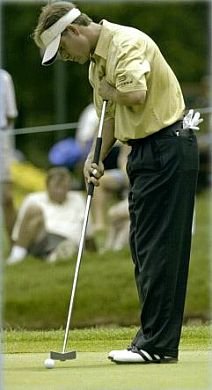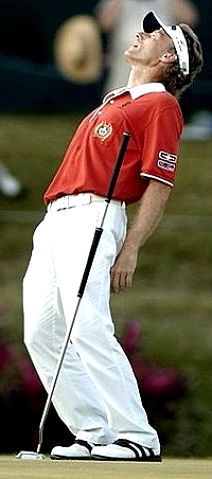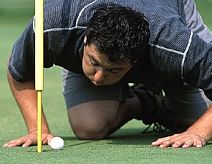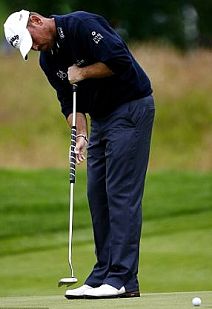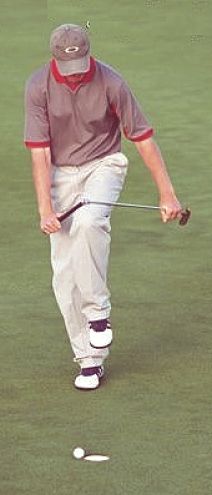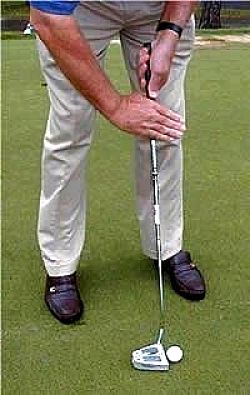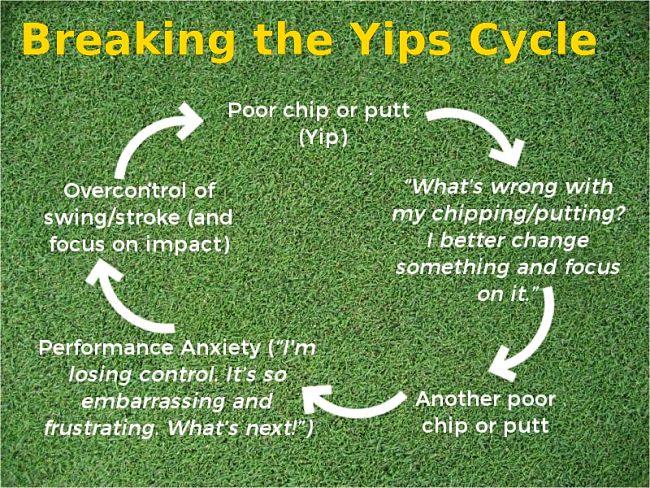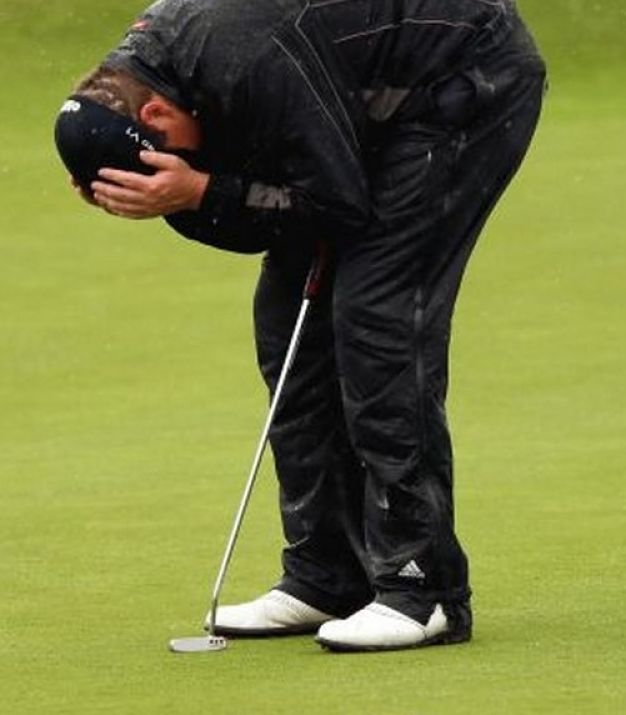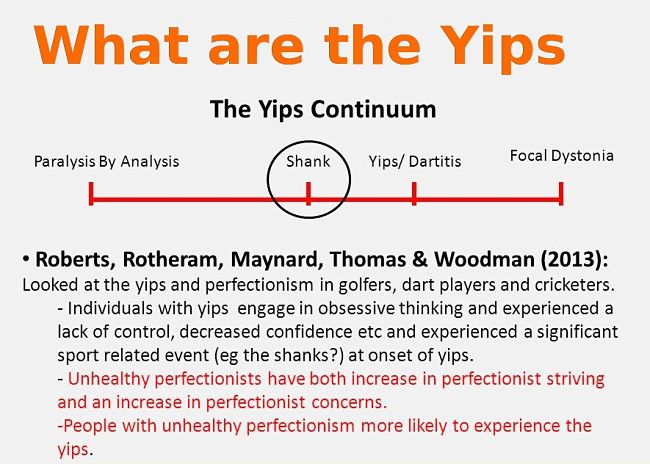The Yips in Golf - Causes, Cures, Learning to Adapt to the Curse of the Yips
Putting is one of the most psychologically affected strokes in golf.
It's 90% peace of mind and confidence, and perhaps 10% technique and club choice.
Of course everyone blames the club - the types and range of putters available is truly astonishing.
Many golfers game is destroyed by bad cases of the dreaded 'yips' also known as 'putters curse', 'the jumps', 'the shakes', 'the jitters' and 'the flinches'.
New research has provided a better understanding of its cause and cure, and how to adapt to it.
This article explores some of the new ideas about the cause of the dreaded yips and how golfers ca n learn to prevent, cope, adapt to and hopefully find a cure for the yips.
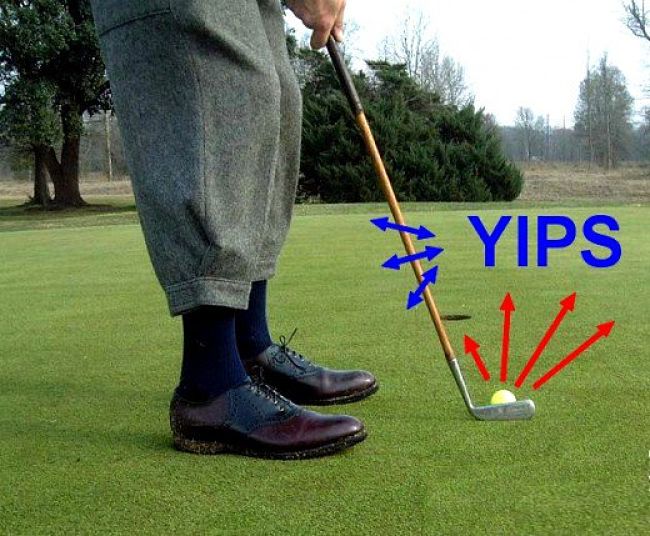
Several famous professional golfers have had the yips including Tom Watson who fought it for most of his career. The sure sign of the curse is the long-shafted putter which many golfers adopt as a last resort to save their career. Other adopt weird grips and strange preparation routines.
Mark Calcavecchia, who was an excellent putter before he developed the yips in the late 1990s, partially overcame the curse
by switching to a claw putting grip. He recalls that he could feel the involuntary twitches in his forearms. Anything short put over a foot and a half became a nightmare with only 50 percent chance of success. The new grip improved it but did not beat it. Watson rejected the solutions of a long putter or changing his grip. He adopted routines to ensure he accelerated through the ball and learnt how to feel confident over the ball, despite admitting he still gets nervous about putting.
The curse of the yips is often related to an erosion of self confidence and an evolving process of nervousness and performance anxiety. Nervousness triggers a loss of confidence and this triggers more nervousness and over compensation by focusing on technique and planning the shot. A bad put from three feet away rots the confidence for the next short put at the next hole and so on. The feed-back mechanism eventually destroys the confidence that is the key to good putting.
Many of golf's stars have battled it and many aspiring champions have had their game and career destroyed by it.
Some of the those that have been afflicted with the curse of the yips are: Lee Trevino, Johnny Miller, Ben Hogan,
Sam Snead, Bernhard Langer and even Tiger Woods.
For many years, the yips were thought to be 'all in the
mind' and two Mayo Clinic research studies pointed to neurological and psychological links to the curse.
But new research suggests a decline in muscular control and sensitivity linked to a buildup of scar tissue in the
forearms may trigger the involuntary twitches that is the catalyst for the yips.
Robert Anthony Prichard conducted a detailed
analysis of the swings of many famous golfers for his popular book, 'The Efficient Golfer'. Some golfers such as Hogan,
Snead and Trevino appeared to have developed a tight grip to restrained their driver swing to limit extension at impact.
Many of these golfers also had the yips. He suggested that the yips and the restrained stroke may be caused by
repetitive strain injury induced by thousands of golf strokes. The driver head, which has got larger and heavier is
whirling through the air at more than 100 miles per hour. There is a centrifugal force pulling on the arms of
the golfer with more than 100 pounds of force. Even though this pull or jerk only lasts for a very short time,
the jerk or drag is repeated over and over again during a game of golf and over many games and practice sessions. Prichard has suggested that in time this strain cause minute tears in muscle fibers of the golfer's forearms and produces scar tissue.
Over a period of time, Prichard suggested that there is a build-up of scar tissue caused by the tension in the forearms due to the centrifugal force of the swing. Golfers may develop involuntary responses to the loss of function causing spasms and loss of sensitivity when gripping and swinging the club. This applies even when golfer grips the putter lightly and activates the same set of scared muscles for the put. The golfers response to deal with these changes affects the gentle stroke of the put.
The cure to the yips, according to Prichard involves finding a way to overcome these problems by changing the stroke to reduce the strain and getting massage therapy and physiotherapeutic treatments to connective tissue and muscles, to release the scar tissue that has accumulated.
Other researchers have stated that the hypothesis of a physical cause for the yips is totally unproven. Some golfers get the yips and then miraculously recover. This is a clear argument again the physical cause and suggests a strong psychological component. Perhaps subtle changes to the grip and swing when putting may reduce the strain when driving via a feed-back mechanisms
Dr. Patrick Cohn, a researcher and founder of Peak Performance Sports accepted that some biomechanical factors could worsen or even trigger he onset of the yips. Fear, worry, loss on confidence and thinking too much about the putting stroke and dwelling on the problem were the main issues.
He suggested that the yips is usually related to over control and thinking too much about the stroke, triggered by anxiety about missing a putt or a shot. It becomes self-reinforcing and erodes confidence. The worry about how to overcome it become the cause of the problem. Over control can happen unconsciously and need not be obvious to the golfer. Golf is a very psychological game during which the golfer is totally alone and is individually responsible for what happens - there is no one else to blame. But the golfer' psyche is subtly influenced by the surroundings and the fellow players behavior and interactions with the player.
Others have made similar claims of a physical cause but related to a neurological rather than a muscular disorder. The Mayo Clinic studies suggested this cause. Many other activities that involve fine-motor hand exercises, like guitar playing, flute playing and even calligraphy can lead to movement disorders after 20 years or more. The nerves and fine control simply develop problems with old age and repetitive use.
However the yips are not confined to older golfers and may have multiple causes. Kids as young as 11 years old have shown signs of the yips, but this may be simply lack of self-confidence. Some people with highly developed hand and arm movement skills such as surgeons can have the yips when putting,even when their skills doing other tasks are unaffected.
It is a sad truth that we will probably never really pinpoint any single exact cause or combination of causes relating to physical, neurological and psychological issues in various combinations. The erosion of confidence and the onset of worry and anxiety triggered by the first bad shot in a game is very hard to overcome as it leads to over control which in turn erodes the confidence. It is a vicious cycle.
Perhaps there is no real cure and the solution lies within each individual. Many golfers can only try to prevent it and find ways to work around it.
